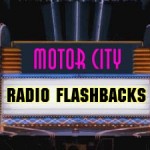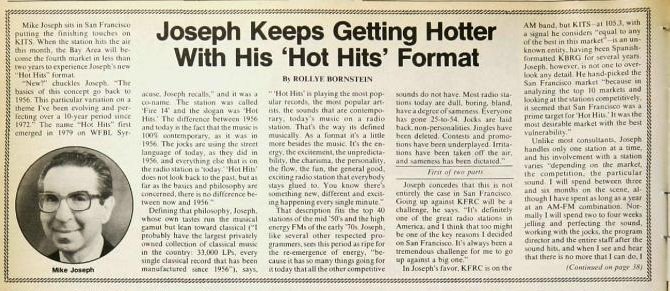 From the MCRFB NEWS archive: 1983
From the MCRFB NEWS archive: 1983
Consultant Joseph Working Top 40 Success Over 20 Years In Business (including Detroit’s WKNR 1963)
— First of two parts —
(see also: Mike Joseph; WJR-FM Seeks New Calls — WHYT-FM July 3, 1982)
M I K E J O S E P H sits in San Francisco putting the finishing touches on KITS. When the station hits the air this month, the Bay Area will become the fourth market in less than two years to experience Joseph’s new “Hot Hits” format.
“New?” chuckles Joseph. The basics for this concept goes back to 1956. This particular variation on a theme I’ve been evolving and perfecting over a 10-year period since 1972.” The name “Hot Hits” first emerged in 1979 on WFBL, Syracuse,” Joseph recalls, “and it was a co-name. The station was called ‘Fire 14’ and the slogan was ‘Hot Hits.’ The difference between 1956 and today is the fact that the music is 100% contemporary, as it was in 1956. The jocks are using the street language of today, as they did in 1956, and everything else that is on the radio station is ‘today.’ ‘Hot Hits’ does not look back to the past, but as far as the basics and philosophy is concerned, there is no difference between now and 1956.”
Defining that philosophy, Joseph, whose own taste runs the musical gamut but leans toward classical (“I probably have the largest privately owned collection of classical music in the country: 33,000 LP’s, every single classical record that has been manufactured since 1956”), says, “Hot Hits” is playing the most popular records, the most popular artists, the sounds that are contemporary, today’s music on a radio station. That’s the way its defined musically. As a format its a little more besides the music. It’s the energy, the excitement, the unpredictability, the charisma, the personality, the flow, the fun, the general good, exciting radio station that everybody stays glued to. You know there’s something new, different and exciting happening every single minute.”
That description fits the top 40 stations of the mid-’50s and the high energy FMs of the early ’70s. Joseph, like several other respected programmers, see this period as ripe for the re-emergence of energy, “because it has so many things going for it today that all the other competitive sounds do not have.
Most radio stations today are dull, boring, bland, and have a degree of sameness. Everyone has gone 25-to-54. Jocks are laid back, non-personalities. Jingles have been deleted. Contests and promotions have been underplayed. Irritations have been taken off the air, and sameness has been dictated.”
Joseph concedes that this is not entirely the case in San Francisco. Going up against KFRC will be a challenge, he says. ” It’s definitely one of the great radio stations in America, and I think that too might be one of the key reasons I decided on San Francisco. It’s always been a tremendous challenge for me to go up against a big one.”
In Joseph’s favor, KFRC is on the AM band, but KITS — at 105.3, with a single he considers “equal to any of the best in this market” — is an unknown entity, having been Spanish-formatted KBRG for several years. Joseph, however, s not one to overlook any detail. He hand-picked the San Francisco market “because in analyzing to top 10 markets and looking at the stations competitively, it seemed San Francisco was a prime target for ‘Hot Hits.’ It was the most desirable market with the best vulnerability.”
Unlike most consultants, Joseph handles only one station at a time, and his involvement with a station varies “depending on the market, the competition, the particular sound. I will spend between three and six months on the scene, although I have spent as long as a year at a AM-FM combination. Normally I will spend two to four weeks jelling and perfecting the sound, working with the jocks, the program director and the entire staff after the sound hits, and when I see and hear that there is no more that I can do, I take off within 24 to 48 hours. I’m then retained for a 52-week period after my leaving the station.”
With the announcement of its air staff, KITS debut is eminent and Joseph’s work is coming to a close. As with most of his stations, many of his jocks are now unknown entities, but Joseph is confident some will emerge as major personalities. “Personality is extremely important to the format. Going over the last 26 years, if you think about the stations I’ve programmed, all had a very strong format, but they developed some of the greatest radio personalities (including Dick Biondi, Bruce Bradley, Scott Muni, Dan Ingram, Bruce Morrow and Gary Stevens). The same thing is happening today. The same thing is happening today. There are important superstars coming out of ‘Hot Hits.’ Fortunately, I’ve always known how to find them. It is time consuming. You have to go through a lot of work to find out who they are and where they are. But they are there, and I’m still able to find them in the small and medium markets. to bring into the majors. They’re just as good as they were 25 years ago.
“I look for potential. Sometimes that personality has to be molded and developed over a long period of time. There is no such thing as an instant personality, but there are some basics that I look for in a personality. You look for the basic good, strong, projected voice that knows how to express, ad lib, communicate. You look for charisma, that spark, that brightness that gives you a lift. You look for a person who is concerned and has friendliness and love in his voice and in his personality. And you look for a someone who knows how to talk to a listener on a one-on-one basis.”
Joseph has been successful reorganizing these qualities for the better part of three decades. Like most legendary radio figures, his love for the business came early on. “My family was in the nightclub and tavern business, and I was a musician myself — a percussionist. In high school, I guess I was one of the first radio groupies. I was always hanging around the local stations and soaking up all I could.”
From his hometown of Youngstown, Ohio, Joseph moved to Cleveland, where he studied pre-law at Western Reserve. “Halfway through college I knew it wasn’t going to be law, but I graduated with a pre-law degree in 1949. Actually, the great education I got turned out to be perfect for a radio career.”
That career started in 1950 in Cochocton, Ohio, where Joseph became program director of WTNS, “one of the most memorable excursions of my life, because that’s where I met my wife.” (Joseph’s wife Eva, had emigrated from East Berlin after World War II). A year later he found himself with Fetzer Broadcasting in Grand Rapids, Mich., where he spent four years as program director of WJEF, a CBS affiliate.
But by 1956, things have changed. “I saw what was happening with network radio. There was a tremendous upsurge in independent broadcasting, and it was the beginning of the Top 40 takeover.
“I felt about top 40 the same way I had felt four years earlier about CBS radio. I did see the writing on the wall, and I did get in on the ground floor at WTAC in Flint, Michigan, which was one of the first top 40 stations in America.
“I went in as program director in December, 1955 and took it top 40 in early 1956. It became one of the highest-rated, most fabled medium-market top 40 stations in America. And that turnaround was so successful that I was made national program director by this particular corporation, Founders, and they gave me their stations in Syracuse, New Orleans and Honolulu. So that was the beginning of my travel era, and I’ve been traveling ever since.”
After two years in that position, Joseph made a bold move. In January, 1958, he decided to go it alone. “That was the first consultancy. In fact, I was trying to figure out what to call myself, and I figured there were management consultants, engineering consultants, why can’t there be a program consultant? So I invented the term.”
Joseph’s first two clients were WMAX Grand Rapids and WROK Rockford, Illinois. “And then I affiliated myself with Avery-Knodel and worked out a deal to consult and program there represented stations,” among which was “the real stepping stone to the big time and a major consultancy for me, the legendary WKBW Buffalo. And that staff I still say is one of the greatest rock staff in the history of rock and roll, including the greatest rock jock ever, Dick Biondi.
“And that was was one of the original “Hot Hits” station. Contrary to what people think today, that the original tight playlist came along in ’65 or ’66, ‘KB’ had 20 records, but it was one of the biggest of that era and is still growing.
“WKBW and then WPRO started my association with Capitol Cities. WPRO Providence was another legendary with another legendary personality, Salty Brine, one of the greatest morning men ever. That was a top 30 station and an immediate turnaround as ‘KB’ was, so I would say that those two stations, more than any other, made me. They created the situation where the entry to WABC became relatively easy.” END
___
(Information and news source: Billboard; February 19, 1983)
![]()


